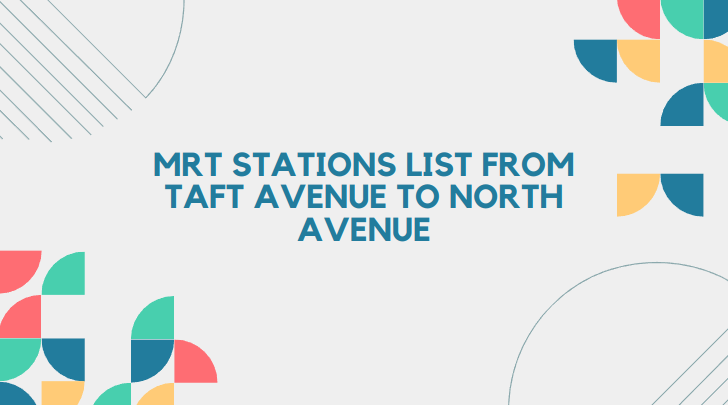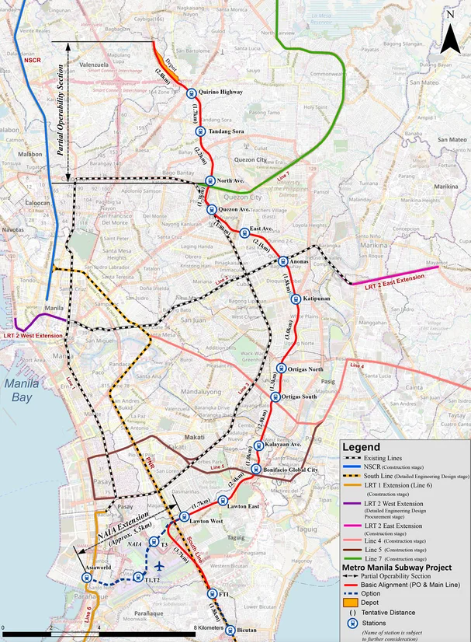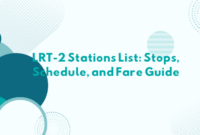Navigating Metro Manila can be quite a challenge, especially with the city’s notorious traffic. However, the MRT Stations List from Taft Avenue to North Avenue provides a vital solution for daily commuters looking to avoid road congestion. Spanning several key cities in the capital region, this train line serves as a convenient and time-saving option for thousands of passengers. Understanding the sequence of stations is essential for planning trips efficiently, ensuring smooth travel across Metro Manila’s busiest routes.
The MRT Stations List covers critical areas in Pasay, Makati, Mandaluyong, and Quezon City, providing access to major business districts, shopping centers, and residential areas. From the southernmost Taft Avenue station to the bustling North Avenue terminal, each stop has its own significance, catering to a diverse set of commuters. Whether you’re new to the city or a seasoned resident, familiarizing yourself with these stations can significantly improve your commuting experience.

Whether you’re new to Metro Manila or have been living here for a long time, three letters can help you navigate the capital region: MRT. Although far from perfect, this train system is the go-to transportation mode for over 300,000 passengers daily. It may often be crowded, but it allows you to avoid the heavy and exhausting traffic in the city.
For beginners, getting to know the train system will make it easier and more efficient to use. This guide provides a list of MRT stations in order and offers a few tips to make your commute smoother, safer, and more comfortable. Expats and city dwellers unfamiliar with the MRT can benefit from this guide.
List of MRT Stations in Order
Goldpriceph.com – At present, the MRT line consists of 13 stations that span along the length of EDSA, serving as a vital transportation link for several cities, including Pasay, Makati, Mandaluyong, San Juan, and Quezon City. This railway system provides a convenient way for commuters to navigate through Metro Manila’s busiest areas, helping them avoid the often unbearable traffic congestion. Understanding the order of these MRT stations is key to planning an efficient and smooth journey, whether you’re commuting for work, school, or leisure.
The MRT stations follow a sequence that begins at Taft Avenue in Pasay and ends at North Avenue in Quezon City, with several important stops in between. These stations connect major business districts, residential areas, and shopping hubs, making the MRT a central transportation option for thousands of daily commuters. Whether you’re starting your journey in the south or heading north, knowing which station to board or alight at can help you save time and avoid unnecessary confusion.
To make your trip easier, it’s helpful to familiarize yourself with the list of stations and how they align with your intended route. By doing so, you can plan ahead, determine the most convenient station for your needs, and ensure a more seamless experience as you move across the different cities served by the MRT. Whether you’re a frequent user or new to the system, understanding the MRT stations and their locations will enhance your commuting efficiency.
Taft Avenue
This station is located in Pasay and serves as a transfer point for passengers heading to LRT-1. It’s close to several provincial bus lines.
Nearby landmarks:
- Ninoy Aquino International Airport
- SM Mall of Asia
- San Juan de Dios Hospital
Magallanes
For those coming from the south, this station is the stop before continuing with the MRT. It’s near the South Luzon Expressway and other major city points.
Nearby landmarks:
- Asia Pacific College
- Assumption College
Ayala
This is probably the busiest station, as it is close to the Makati Central Business District and Bonifacio Global City.
Nearby landmarks:
- SM Makati
- Glorietta
- Greenbelt
Buendia
Also known as Gil Puyat Station, this is one of the two underground stations on the MRT line.
Nearby landmarks:
- Department of Trade and Industry
- Century City Mall
Guadalupe
Guadalupe Station provides access to many key points in Metro Manila, including eastern Makati, Fort Bonifacio, and Mandaluyong.
Nearby landmarks:
- Rockwell Center
- PowerPlant Mall
Boni
For destinations in Mandaluyong, particularly in the Pioneer area, this station is your best option. It’s close to universities and residential complexes.
Nearby landmarks:
- Rizal Technological University
- SM Light Residences
Shaw Boulevard
Shaw Boulevard Station serves the Mandaluyong area and is a central terminal with two tracks. It’s ideal for commuters heading to Ortigas Center and Greenfield District.
Nearby landmarks:
- Shangri-La Plaza
- San Miguel Corporation
Ortigas
This station serves most of the Ortigas Business District and is the last station in Mandaluyong when coming from the south.
Nearby landmarks:
- Robinson’s Galleria
- SM Megamall
Santolan-Annapolis
Located between Annapolis Street and Santolan Road, this station is a reference point for the Philippine National Police Headquarters.
Nearby landmarks:
- Camp Crame
- Camp Aguinaldo
Araneta Center-Cubao
This is one of the busiest MRT stations, as it serves as a transfer point for passengers taking LRT-2.
Nearby landmarks:
- Araneta Coliseum
- Ali Mall
Kamuning
Named after Barangay Kamuning, this station is close to an entertainment district in Quezon City.
Nearby landmarks:
- GMA Network
- Quezon Memorial Circle
Quezon Avenue
Quezon Avenue Station is frequented by students as it is close to the University of the Philippines Diliman.
Nearby landmarks:
- Philippine Science High School
- UP-Ayala Technohub
North Avenue
The final station on the MRT line, North Avenue, directly connects to TriNoma, one of the largest malls in Quezon City.
Nearby landmarks:
- TriNoma
- SM City North EDSA

How to Use the MRT: A Beginner’s Guide
Here’s a simple guide to help you navigate the MRT, from purchasing your tickets to ensuring your safety throughout the journey. When riding the MRT, you have the option to either buy a single-journey ticket for one-time use or opt for a reloadable card, which is more convenient for regular commuters. These two choices allow you to select what works best for your travel needs, depending on how often you use the train.
To make your MRT experience smoother, it’s important to familiarize yourself with some safety tips. Always be mindful of your belongings, especially in crowded stations, and keep your bags secure. Staying alert while boarding and following station rules will also contribute to a safe and hassle-free trip. By preparing ahead and knowing what to expect, your daily MRT commute can become more efficient and comfortable.
Important Tips for MRT Commuters
To make your ride more comfortable, remember to wear comfortable clothing, avoid rush hours, and always keep an eye on your belongings. Using a beep™ card can also help reduce wait times at the ticket booth.
Conclusion
Despite having some shortcomings, the MRT remains one of the most reliable modes of transportation in Metro Manila. Using the MRT allows passengers to bypass the frequent traffic congestion in the city. By understanding and memorizing the order of MRT stations, passengers can plan their trips more effectively, ensuring a faster and more efficient journey to their destination.
In addition to minimizing the impact of traffic, the MRT also offers a more practical and affordable alternative for daily commuters. With routes passing through major cities, this transportation option becomes the top choice for many residents seeking better mobility solutions. Although not perfect, the MRT continues to make a significant contribution to the public transportation system in Metro Manila.





